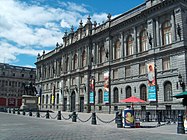File:José María Obregón - The Discovery of Pulque - Google Art Project.jpg
Appearance

Size of this preview: 728 × 599 pixels. Other resolutions: 292 × 240 pixels | 583 × 480 pixels | 933 × 768 pixels | 1,244 × 1,024 pixels | 2,386 × 1,964 pixels.
Original file (2,386 × 1,964 pixels, file size: 1.13 MB, MIME type: image/jpeg)
File history
Click on a date/time to view the file as it appeared at that time.
| Date/Time | Thumbnail | Dimensions | User | Comment | |
|---|---|---|---|---|---|
| current | 12:10, 5 January 2013 |  | 2,386 × 1,964 (1.13 MB) | DcoetzeeBot | =={{int:filedesc}}== {{Google Art Project |commons_artist= |commons_title= |commons_description= |commons_date= |commons_medium= |commons_dimensions= |commons_institution= |commons_location= |commons_references= |commons_object_history= |commons_exhibi... |
File usage
The following 5 pages use this file:
Global file usage
The following other wikis use this file:
- Usage on bn.wikipedia.org
- Usage on www.wikidata.org
- Usage on zh.wikipedia.org


